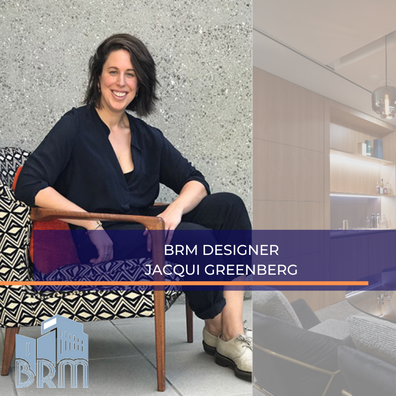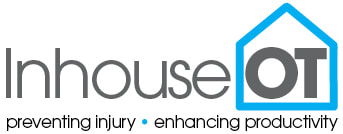|
Eleanor Eshel: OT & Ergonomist at InHouse OT Every project we deliver reflects our commitment to healthy workplaces so it's safe to say that Ergonomists are our friends here at BRM Projects! Today we sat down with Eleanor Eshel, one of our favourites in the business of OT and Ergonomics. In this interview Eleanor offers us a helpful perspective on the role of ergonomics in business and general workplace wellbeing..... Tell us a bit about your work as an ergonomist. What kind of businesses/industries do you work with? As an Ergonomist, I focus on fitting the task to the worker, in order to maximise productivity, whilst reducing risk factors, such as injury, discomfort and fatigue. I view Ergonomics as both an ‘art’ and a ‘science’ because I need to look at creative solutions for design improvement, to account for people’s inherent differences and diverse requirements, whilst also looking at scientific evidence to support my recommendations. Working at In House OT has enabled me the opportunity to work across a number of workplaces and industries, including hospitality, retail, manufacturing and machine operation; in this capacity, I am usually engaged as a reactive measure, following an incident or issue that needs to be addressed to avoid future risk. Currently however, my main client base has been predominately working within the office environment where I have the opportunity to work proactively with people, both in terms of providing advice regarding general workstation set up and posture, as well as task and office design and fit out -which is something I particularly enjoy. Where does ergonomics fit in to the general sphere of "Wellbeing in the workplace"? Recently, there has been a growing awareness of the concept of “wellbeing at work”, with many employers providing “wellness programmes”, which offer benefits such as gym memberships, Quit programmes, bike racks, health assessments, EAP and health lunch education to name a few – however without optimal design of the worker’s task and their environment, the risk of physical and psychological injury remains high. We know for a fact that work as a concept is positive – work provides structure, meaning, and routine; it reduces poverty and social exclusion; health indicators for workers are more positive than for those of non-workers, with lower levels of smoking, lower levels of obesity, and higher engagement in activity. For a worker to reap the positive benefits of work, Ergonomics is vital. Ergonomics is a preventative, design based discipline- we hold the view that design for health and productivity, reduces the incidence of injury and discomfort risk factors. Ergonomics is also known as Human Factors; it is not just about the physical posture, it also looks at psychological, cognitive and organizational issues that can impact on a worker. By consulting with an Ergonomist and embedding this philosophy into the culture of the workplace, the employer can better understand the effects that the tasks, equipment and environment has on the worker, and harness this information to support overall wellbeing, whilst also increasing performance. Is there a direct relationship between a business's bottom line and good ergonomics? Absolutely- the economics of Ergonomics is well researched. We know that implementing an effective ergonomic programme can on average, result in 1:19 cost benefit ratio, with any costs spent paid back in less than 9 months. These costs take into account the hidden costs of absenteeism and presenteeism- with 75% fewer lost work days, 68% reduction in worker’s compensation claims, 48% decrease in staff turnover and 25% increase in productivity. At In House OT, we offer a number of services to assist with implementing effective ergonomic programmes, including individual and group education sessions, individual workstation assessments, and ‘Train the Trainer’ programmes to allow frontline staff to assist with entrenching Ergonomic philosophy into the workplace culture. In recent years, changing technology would have shaped new concerns for employees. How do you deal with these concerns from an ergonomics point of view? Our access and time spent using technology has increased significantly in recent years. In the past year, Australians spent more time on the Internet than working, spending 21.9 billion hours on the Internet in one form or another – whether at home, at school, while at work or elsewhere, compared to 20.5 billion hours on the job. A significant portion of this ‘tech time’ is spent on handheld devices- such as phones, tablets and laptops. What this means, is that we are seeing an increase in reported musculoskeletal disorders, with media attention on syndromes such as “iPad neck” and “text thumb”. Workplace trends and the way we work have also shifted- we have moved away from personal offices, to open plan environments, hot desks, Activity Based Work (ABW) and are moving to agile work design and increased use of co-working spaces. Globally, the boundary between working and home life is rapidly disappearing, with nearly 25 million people working in their home at least one day a week, without necessarily having a dedicated home office or work space. There has also been increased media attention on sustained postures, such as “sitting is the new smoking” which further confuses people as to how they should best work to maintain their health. From an Ergonomics perspective, we try and give people the tools to understand what the “optimal scenario” looks like, and how to achieve this in a variety of settings. In the real world, we don’t always have the ability to replicate the optimal posture when we move from office to the home, or a client site, but if there is a clear understanding of why Ergonomic principles are important, how to implement these, and when to take breaks, we can affect some behavioral change and improve worker overall comfort. BRM Projects loves to support businesses that promote a healthier workplace. Visit InHouse OT to check out its services and contact BRM Projects to see what we've been up to on the Workplace Wellbeing front!
0 Comments
Your comment will be posted after it is approved.
Leave a Reply. |
Sign Up To Our NewsletterArchives
September 2023
Categories
All
|
BRM |
QUICK LINKS
|

 RSS Feed
RSS Feed


